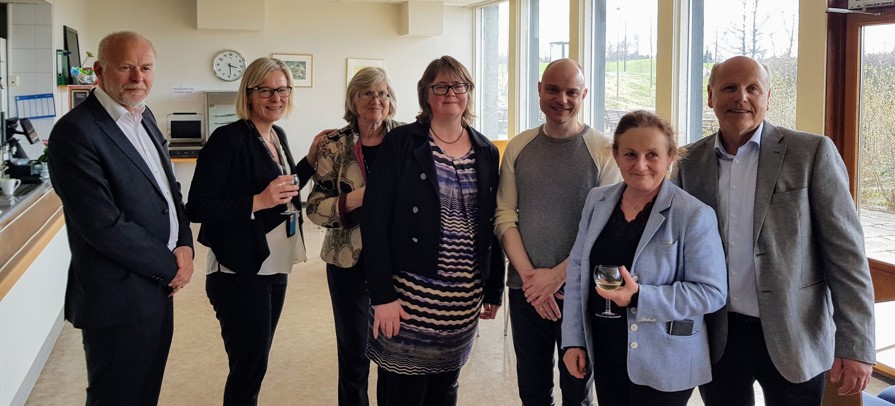Regin Arge vart ph.d. á NMBU
Fríggjadagin 4 mai vardi Regin Arge ph.d. ritgerð sína á Norges Miljø- og Biovitenskapelige Universitet (NMBU).
Heitið á ritgerðini er: “Tetradecylthioacetic acid (TTA) – A functional feed ingredient for Atlantic salmon affecting early sexual maturation, cardiac robustness and β-oxidative capacity”.
Regin hevur kannað fitievnaskiftið í laksi og serliga, hvussu laksur umsetur fiti í vøddunum, alt eftir stødd, kyni og árstíð. Tílíkur kunnleiki er t.d. avgerðandi í royndum at fyribyrgja, at alilaksur kynsbúnast ov tíðliga. Eisini varð kanna nærri, hvussu orkuføri í hjørtum á alilaksi kann betrast. Hetta hevur týdning fyri, hvussu stinnur laksurin er undir orkukrevjandi umstøðum, ella í støðum, ið kunnu elva til strongd.
Í metingarnevndini vóru Jana Pickova, professari á Swedish University of Agricultural Sciences (SLU), Uppsala Svøríki og Mette Sørensen, professari á Nord University í Bodø. Tær vóru uttanhýsismetarar. Innanhýsismetari var Øystein Holand, professari á NMBU. Kari Kolstad dekanur, leiddi verjuna vegna NMBU.
Vegleiðarar hjá Regini vóru Kjell-Arne Rørvik professari, sum starvast á Nofima og NMBU) og Magny S. Thomassen, professari á NMBU.
Verjan fríggjadagin gekk sera væl.
Ph.d.-verkætlanin varð fíggjað av Norges Forskningsråd, Nofima, Fiskaaling og Granskingargrunninum.
Regin arbeiðir hjá Marine Harvest, ið eisini hevur víst vælvild og stuðul.
Les um verkætlanina í Stuðulsyvirlitinum
Enskur samandráttur
Utilisation of fatty acids highly dominates energy metabolism in high performance fish as the Atlantic salmon. It is well established knowledge that feed intake and growth of salmon is highly influenced by water temperature and day length. Another significant factor influencing growth and fat deposition in Atlantic salmon, is the initiation of puberty and the development in sexual maturation. Previous research has shown that maturation in salmon is a complex process depending on different stimuli gained from both external factors like photoperiod and internal factors like age and state of energy reserves. After the maturation process has been initiated during early winter, it has been shown that the availability of appropriate energy reserves during the spring period is a major factor affecting continuance of the maturation process, and low energy or fat levels may arrest further progress. Female salmon are known to invest more energy in the development of gonads than male salmon, hence, females normally mature later in life than males, most often in the autumn after two or more sea winters. The combination of these factors significantly influences the production biology of farmed Atlantic salmon and is the scope of this thesis.
In this thesis tetradecylthioacetic acid (TTA) is strategically used in the test diet to alter the fat accumulation in farmed S0 Atlantic salmon muscle during their first spring at sea (paper I). It is shown that lower fat accumulation in spring leads to reduced incidence of early maturation in male grilse in the succeeding autumn by 1/3 compared to the control group receiving the same feed without TTA supplementation. To describe the decrease of TTA in fish muscle after termination of TTA supplementation in the feed, an elimination model is further developed in this study (paper I). As salmon females normally mature at later life stage compared to males, another experiment with S1 salmon was conducted to investigate possible different responses between the sexes regarding TTA treatments (paper II). It is shown that muscle fat in males and females differed significantly as a response to dietary TTA. The muscle fat content during the first spring was significantly lower in females compared to males. In contrast, during the second spring, fat content was significantly more reduced in males than in females. Condition factor is shown to follow a similar pattern as muscle fat. The results in paper II indicate that the difference in male and female fat accumulation dynamics is related to sex-specific reproduction biology of Atlantic salmon.
To obtain more insight into the response to TTA treatments, a study of the salmon heart was selected due to its characteristics as a highly energy consuming vital organ (paper III). It is shown that fish given TTA supplemented feed had a smaller decrease in heart weight relative to fish bodyweight (CSI) in a period after sea transfer compared to the control. This coincided with lowered condition factor and muscle fat in the treated fish. To examine this further, isolated salmon heart cells were held in culture and pre-stimulated with TTA in order to increase the endogenous concentration of this bioactive component. Radiolabelled fatty acid (FA) was supplemented to culture media to study the effects of endogenous TTA on uptake, incorporation in lipid classes and β-oxidation. It is shown that heart cells receiving 120µM TTA had higher uptake of radiolabelled FA and formation of the β-oxidation products CO2 and other acid-soluble products. The molecular mechanisms underlying this were studied in an additional experiment. Salmon held in tanks on land were subjected to injections of TTA in increasing doses. By using gene expression (real-time quantitative RT-PCR) analyses, it is shown that genes regulating cell growth, peroxisomal FA oxidation, FA elongation and desaturation, were upregulated in the heart of TTA treated fish. In contrast, genes involved in FA transport into the mitochondria were not influenced. Taken together, the findings in paper III show that TTA treatments lead to increased heart size, possibly by increasing the expression of genes regulating heart cell growth and enhanced energy production by stimulation of FA oxidation.
In conclusion, the findings in this thesis demonstrate that TTA in defined doses, without compromising fish growth, may successfully be used strategically during energy demanding periods for the fish. Additionally, TTA reduces incidence of early sexual maturation, increases cardiac robustness and oxidative capacity in farmed salmon. Further, the effect of TTA may be influenced by the sex and size of the fish.
Implementation of the knowledge generated by the work in this thesis has the potential of being beneficial for the salmon farming industry.
